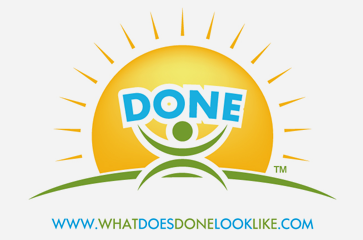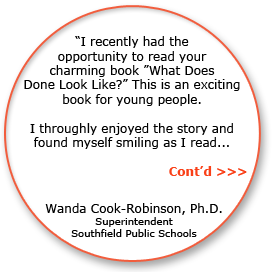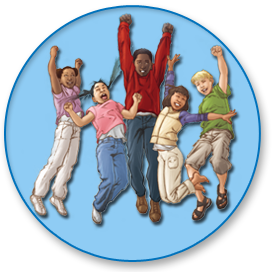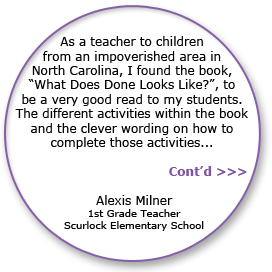I have had the pleasure of reading and being asked to review “What Does Done Look Like?” It was exciting to see such a creatively and well-written book for children. The book illustrates the key concepts of follow through, not giving up, not taking short cuts, and task completion using day to day examples that typically occur in a child’s environment. These concepts become basic tools that assist children in navigating the stages of childhood development and the challenges those stages present. This in turn lays the foundation for successful emotional and psychological functioning as an adult.
The setting of the story, a child’s world, also allows parents to reinforce the concepts of the book using simple tasks that are familiar to their child. This more easily facilitates the transfer of information in the book to their daily lives.
It is most impressive that the author created a book that is both simple enough for children to enjoy and at the same time complex enough for educators and parents to use as a teaching tool.
GREAT WORK!!!!!
Jacqueline S. Jackson, Ph.D.
Clinical Psychologist
|
|
| |
Dear Mr. Jones,
I recently had the opportunity to read your charming book “What Does Done Look Like?” This is an exciting book for young people. I thoroughly enjoyed the story and I found myself smiling as I read through the pages.
I noted that the characters you created are true to life and the words are familiar to the family environment. This book is an excellent example of how to instruct young children in the area of personal responsibility.
“What Does Done Look Like?” is a must read for children in grades Kindergarten through sixth grade. Thank you for sharing this book with me and I hope your future endeavors are even more successful.
Sincerely,
Wanda Cook-Robinson, Ph.D.
Superintendent
Southfield Public Schools |
|
| |
Scurlock Elementary School
775 Rockfish Rd., Raeford, NC 28376
Statement of testimony to the book entitled: “What Does Done Look Like?”
September 9, 2011
As a teacher to children from an impoverished area in North Carolina, I found the book, “What Does Done Looks Like?”, to be a very good read to my students. The different activities within the book and the clever wording on how to complete those activities really appealed to the students interests. For example, the child washing dishes with their mother until they were all clean actually showed students how to help out their parents and how to properly care for their home.
Another benefit of the book was for the students to each see themselves in the characters from the book. This was due to the fact that the book included many ethnicities. The visual multicultural representations allowed the students to feel a part of the story and actually capable of understanding and feeling these tasks are actually real and capable for them.
Activity: After reading the story to my students they drew a picture and wrote a story about what they think done looks like. They were very responsive and had creative ideas. One student drew a picture that told about how she knew she was done with her homework when her mother checked it.
In conclusion the book “What Does Done Looks Like?” should be in teacher’s classrooms as a tangible reference to students understanding of responsibility and accomplishment. My class really enjoyed it and continuously picked it out of our classroom library to read and reread it. I look forward to seeing this book become more prevalent in classrooms, guidance counselor offices and even in administrators hands.
Alexis Milner
1st Grade Teacher:
Scurlock Elementary School Raeford NC
|
|
| |
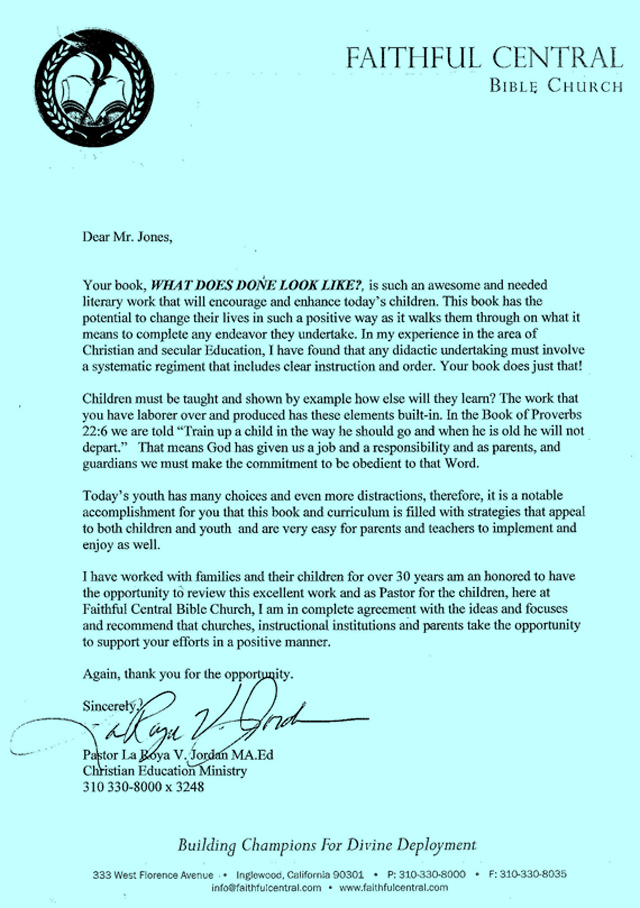 |
|
